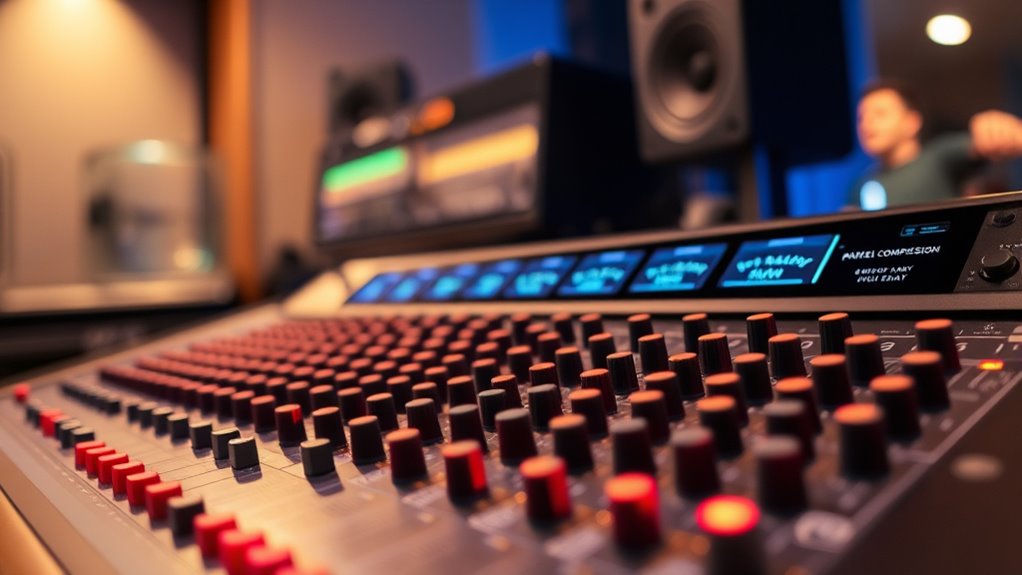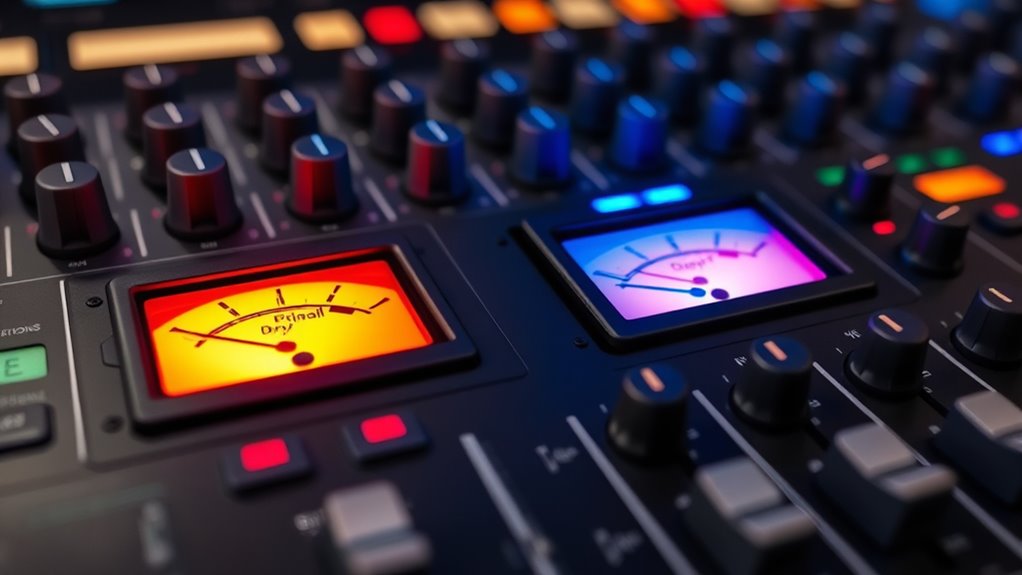Many believe parallel compression kills your mix’s dynamics, but that’s false if you use it correctly. When set up properly, blending a heavily compressed signal with the original preserves transients, punch, and natural energy. Avoid overdoing it or increasing wet signals too much, which can cause muddiness and phase issues. Balancing your signals and adjusting parameters carefully lets you boost impact without sacrificing realism. Stick with this approach, and you’ll access the full potential of parallel compression.
Key Takeaways
- Properly set compression parameters to preserve transients and avoid over-squashing the signal.
- Use moderate ratios and gentle gain reduction to maintain natural dynamics.
- Blend dry and compressed signals carefully to prevent frequency masking and phase issues.
- Avoid excessive compression; focus on enhancement rather than total control to keep lively sound.
- Understand that dynamic range can be preserved with correct technique, dispelling the myth of inevitable loss.
Understanding the Basics of Parallel Compression

Parallel compression is a powerful technique that allows you to blend a heavily compressed signal with the original, unprocessed sound. It’s a versatile tool for dynamic control, helping you tame peaks while preserving natural transients. By applying compression techniques selectively, you can enhance sustain and fullness without sacrificing clarity. The key is to maintain the balance between the compressed and uncompressed signals, giving you more control over the track’s energy. This approach prevents the mix from becoming overly squashed, ensuring you preserve the original dynamics. Using parallel compression, you can emphasize certain elements, like vocals or drums, without losing the natural feel. It’s an effective way to add punch and thickness, all while keeping your sound lively and dynamic. Additionally, understanding sound healing science can inspire creative ways to utilize frequencies and vibrations in your mixing process.
Common Myths About Dynamic Range Loss

Many believe that using compression automatically causes significant dynamic range loss, but that’s not always true. Overcompression can reduce contrast if you’re not careful, yet proper settings can preserve punch and detail. Don’t assume loudness equals better; understanding dynamic range helps you make smarter mixing choices. Additionally, mastering sound effects layering techniques allows for more nuanced control over your audio’s spatial and emotional qualities.
Overcompression Risks
A common myth about parallel compression is that it inevitably leads to overcompression and a significant loss of dynamic range. While it’s true that heavy compression can reduce dynamics, using vintage compressors with a focus on transient preservation helps prevent this. These compressors can smooth out peaks without squashing the entire dynamic range, maintaining punch and clarity. Properly setting the ratio, attack, and release ensures you avoid overcompressing the signal. When done correctly, parallel compression enhances presence and thickness without sacrificing the natural ebb and flow of the performance. The key isn’t in avoiding compression altogether but in using it judiciously with the right tools, like vintage gear designed to preserve transients while controlling peaks. Additionally, understanding the role of dynamic range in mixing helps you apply compression more effectively.
Misunderstanding Dynamic Range
One common misconception is that dynamic range loss occurs automatically whenever compression is used, but that’s not always the case. Properly applied compression can preserve or even enhance your track’s dynamic range by controlling peaks without squashing the quieter parts. The key is how you set your parameters; overly aggressive settings can introduce compression artifacts that degrade audio quality and reduce the perceived dynamic range. Additionally, understanding the concept of dynamic range and its preservation is crucial in applying compression effectively. Many believe that any compression will kill your track’s dynamic range, but this isn’t true if you understand how to use it carefully. Avoiding excessive compression artifacts is essential, as they can make your mix sound unnatural and lifeless.
False Assumptions About Loudness
A common myth about compression is that increasing loudness always leads to a significant loss of dynamic range. In reality, loudness perception isn’t solely dependent on volume; it’s influenced by how you shape the dynamics. Over-compression can dull your mix, but subtle parallel compression preserves the natural feel. Additionally, understanding the importance of artistic expression helps you make informed decisions about dynamic processing. Here are key points to contemplate:
- Loudness perception can be maintained with careful control, avoiding the misconception that louder always means less dynamic.
- Volume normalization helps keep levels consistent without necessarily sacrificing dynamic nuance.
- Properly applied parallel compression enhances perceived loudness without crushing your mix’s transients.
- Balancing loudness and dynamics ensures your mix sounds full and engaging, rather than flat and lifeless.
Understanding these ideas helps you use compression creatively without sacrificing the dynamic range that keeps music lively.
How to Set Up Parallel Compression Effectively

To set up parallel compression effectively, start by choosing the right hardware that fits your workflow. Then, balance the dry and wet signals so the compressed sound enhances without overpowering the original. Finally, fine-tune your compression settings to achieve a natural, punchy result. Remember to be aware of emotional support principles, ensuring your technique maintains the integrity of the original dynamics while adding the desired impact.
Choosing the Right Hardware
Choosing the right hardware is essential for setting up parallel compression effectively, as it directly impacts your ability to blend compressed and uncompressed signals seamlessly. Your hardware selection determines the quality and reliability of your setup, making equipment durability a key factor. To optimize your setup, consider these points:
- Use high-quality, low-latency audio interfaces to prevent timing issues.
- Select hardware with stable power supplies to ensure consistent performance.
- Invest in durable units that can withstand extended use without degradation.
- Ensure your equipment has adequate shielding to minimize electromagnetic interference and maintain signal integrity.
Focusing on robust equipment helps maintain signal integrity and reduces troubleshooting time. Reliable hardware ensures your parallel compression process remains transparent and effective, letting you achieve the desired mix without technical distractions. Prioritize durability and quality in your hardware choices for smooth, professional results.
Balancing Dry and Wet Signals
Achieving a balanced blend of dry and wet signals is essential for effective parallel compression. If the wet signal overwhelms the dry, you risk frequency masking, where certain tones become muddled or lost. To prevent this, start by gradually introducing the compressed (wet) signal while listening for how it impacts clarity and overall tone. Adjust the levels until you find a sweet spot where the compression enhances punch without cluttering the mix. Consider stereo width—overly wide parallel signals can create a disjointed feel, while a more centered blend maintains cohesion. Use panning and level balances carefully to preserve the natural stereo image. The goal is to enhance the sound without compromising the original dynamics or spatial integrity. Additionally, understanding dynamic range and how it interacts with parallel compression can help you fine-tune your settings for optimal clarity and punch.
Fine-Tuning Compression Settings
Setting up parallel compression effectively requires precise control over your compressor’s parameters. To avoid unwanted compression artifacts and phase issues, you need to fine-tune settings carefully. Start by adjusting the attack and release times to preserve transients and maintain clarity. Use a moderate ratio to prevent over-compression, which can lead to unnatural sound. Keep an eye on the gain reduction to avoid artifacts that muddy your mix. To guarantee phase coherence between the dry and compressed signals, consider using a linear-phase EQ after compression if needed. Being aware of passive voice usage can help make your instructions clearer and more direct.
The Impact of Over-Compressing the Parallel Channel

Over-compressing the parallel channel can considerably diminish its intended purpose of adding punch and presence to your mix. When you push compression too hard, you risk frequency masking, where certain sounds become drowned out or muddy due to overlapping frequencies. This reduces clarity and can make your mix sound cluttered. Additionally, over-compression can negatively impact stereo imaging, collapsing the spatial width and making your mix feel less open. Instead of enhancing dynamics, excessive compression flattens the sound, stripping away natural variation. To avoid this, set compression parameters carefully, aiming for subtle gains that retain the channel’s energy without overpowering the original signal. Properly balanced parallel compression preserves clarity, maintains stereo width, and ensures your mix remains lively and punchy. Be mindful of the natural variation in your mix to prevent over-compression from removing the dynamic nuances that add life to your sound.
Balancing the Wet and Dry Signals for Natural Sound

Balancing the wet and dry signals is key to preserving a natural, cohesive sound in your mix. Proper signal blending ensures the compressor enhances without overpowering the original tone. To achieve this, focus on phase alignment to prevent phase cancellation that can dull your sound. Adjust the blend control carefully, listening for a seamless integration of the compressed and uncompressed signals. Keep these ideas in mind:
- Use phase correction tools if necessary to align signals perfectly
- Gradually increase the wet signal while monitoring for artifacts
- Regularly toggle between wet and dry to maintain natural dynamics
When to Use Parallel Compression for Different Instruments

Knowing when to apply parallel compression to different instruments can markedly shape your mix’s impact and clarity. Use instrument-specific techniques to determine the right moments—such as adding punch to drums or enhancing sustain in guitars. For example, in rock or pop, parallel compression can thicken drums without losing their attack, while in jazz, it helps preserve dynamic nuance. Genre-based strategies guide your decisions: in EDM, parallel compression on basslines can add weight, whereas in classical recordings, it’s best used sparingly to maintain natural dynamics. Pay attention to each instrument’s role and how compression influences its character. Applying parallel compression selectively guarantees you enhance clarity and presence without sacrificing the natural flow of your mix.
Avoiding the Trap of Over-Processing Your Mix

While it’s tempting to keep tweaking your mix until everything sounds perfect, over-processing can easily strip your track of its natural vibe and dynamics. Many fall for compression myths that suggest more is always better, but excessive use can narrow your dynamic range and make your mix sound flat. To avoid this trap, remember:
- Use compression subtly to preserve the natural ebb and flow.
- Focus on maintaining dynamic range instead of squeezing everything into a narrow band.
- Regularly compare your processed mix to the original to ensure you’re not overdoing it.
Keeping these principles in mind prevents your mix from sounding overworked and preserves the energy that makes your track compelling. The goal is to enhance, not eliminate, natural variation.
Tips for Achieving Punch and Clarity Without Sacrificing Dynamics

To achieve punch and clarity without sacrificing your track’s natural dynamics, focus on targeted compression techniques that enhance attack and presence without overdoing it. Use subtle saturation effects to add warmth and harmonics, making elements stand out without harshness. Employ stereo widening carefully; too much can smear transients or reduce punch. Balance your compression ratio and attack time to preserve transients, ensuring the track remains lively. Consider parallel processing for drums or vocals—boosting the attack while maintaining the original feel. Here’s a quick overview:
| Technique | Purpose | Caution |
|---|---|---|
| Saturation effects | Add warmth and harmonic richness | Avoid over-saturating |
| Parallel compression | Enhance punch without squashing | Keep levels balanced |
| Stereo widening | Create spaciousness | Prevent phase issues |
| Attack time adjustment | Preserve transients | Don’t slow attack excessively |
Frequently Asked Questions
Can Parallel Compression Be Used on Individual Tracks or Only on Buses?
You can absolutely use parallel processing on individual tracks, not just buses. By blending the dry track with a heavily compressed version, you control dynamics and add punch or sustain. This track blending technique lets you shape your sound precisely, giving you more flexibility. So, don’t limit yourself—parallel compression works great on vocals, drums, or any instrument where you want to enhance presence without losing natural dynamics.
What Are the Best Compressor Settings for Different Genres When Using Parallel Compression?
Imagine your mix transforming instantly—parallel compression can do that! For genres like pop, set a gentle compression ratio around 4:1 with a fast attack to catch transients, and a medium release to maintain groove. For heavy genres like metal, crank up the ratio to 8:1, slow the attack to preserve punch, and adjust the release for sustain. Tailor attack and release to keep your dynamics lively without overwhelming the mix.
How Does Parallel Compression Differ From Traditional Compression in Mix Strategies?
You should know that parallel compression differs from traditional compression by blending a heavily compressed signal with the original, preserving compression transparency and dynamic range. Unlike standard compression, which can reduce the mix’s liveliness, parallel compression enhances presence without sacrificing dynamics. It’s a powerful technique to add punch and sustain while maintaining the natural feel of your mix, giving you more control over the overall sound.
Are There Specific Plugins Recommended for Effective Parallel Compression?
Imagine your mix as a symphony—certain tools can elevate it effortlessly. For effective parallel compression, you should explore plugin recommendations like Slate Digital’s FG-400, Waves’ CLA-76, or Softube’s Tube Compressor. These processing techniques help you achieve punch and warmth without sacrificing dynamics. Choose plugins that suit your style, and remember, the right tool can turn a good mix into a great one—think of it as your secret weapon.
How Do I Avoid Phase Issues When Blending Dry and Compressed Signals?
To avoid phase issues when blending dry and compressed signals, focus on phase alignment first. Use your DAW’s phase alignment tools or manually nudge the compressed track to match the dry one. Check stereo imaging to make certain it remains balanced and clear. Always listen critically in mono to detect phase problems. Proper phase alignment preserves clarity, maintains stereo width, and prevents your mix from sounding hollow or out of phase.
Conclusion
So, next time you plunge into parallel compression, remember it’s all about balance — not turning your mix into a squashed mess. Ironically, the more you focus on preserving dynamics, the better your track sounds. Don’t fall for the myth that more compression equals more punch; sometimes, less really is more. Master it wisely, and you’ll find your mixes punchy and lively — without sacrificing that precious sense of life.










